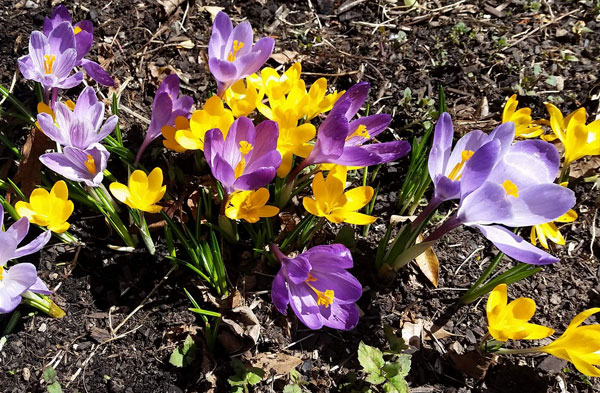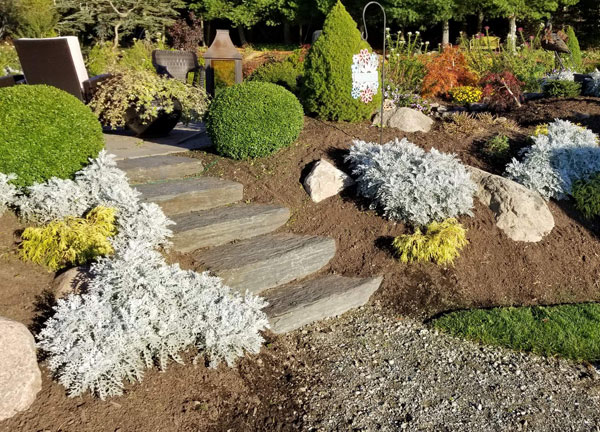Oh my, the light is bright in my eyes as I emerge from Garden Writer’s Hibernation into the warm April sunshine. It doesn’t take long at all though, as the last bits of snow fade away, for spring fever to fire up my gardener’s urge to get out and play in the dirt. Tonight’s warm rain should accomplish that first step…banish the white. Now I hope for a couple days of drying wind and sun so I can indeed get my hands and tools into the soil.
 How is Mother Nature doing with spring so far this year? She scared us with extreme cold after Christmas. No snow to shield the ground and plants from deep frost. Then she moderated for the rest of the winter, allowing a fair portion of that frost to ease away. Snow wasn’t an issue in our coastal climate, and so mild was February that the ice left our rivers in near record early time. That’s generally a sign of an early spring, but a few March snows slowed the trend. They are by us now (surely!), and now it’s the luck of the draw, as spring weather can be disappointingly cool and wet, or have us out gardening and golfing in April.
How is Mother Nature doing with spring so far this year? She scared us with extreme cold after Christmas. No snow to shield the ground and plants from deep frost. Then she moderated for the rest of the winter, allowing a fair portion of that frost to ease away. Snow wasn’t an issue in our coastal climate, and so mild was February that the ice left our rivers in near record early time. That’s generally a sign of an early spring, but a few March snows slowed the trend. They are by us now (surely!), and now it’s the luck of the draw, as spring weather can be disappointingly cool and wet, or have us out gardening and golfing in April.
I used to struggle to find a tip of some bulb in some garden in early April to put in my first couple columns, thinking every photo I ever show you should be totally current. Now I’ve eased the pressure on myself, and for this column and maybe the next, I show you last-year shots from my garden that we can all look forward to in the coming weeks and months. The first today is a classic- cheerful crocuses in full bloom on April 30 last year, which was a late spring, the river ice leaving 6 weeks later than this year, and snow hanging around longer too. I bet some of you have crocuses like that already this year. And I bet some of you have only crocus stems, and hopes that crocus petals at least cause indigestion in deer…
A point of colour selection I love to make: if you can think to pair complementary colours like these, the effect is striking. That means opposite colours on the colour wheel (Google it please). Red with green, blue with orange, and violet with yellow. These crocuses pick up on the latter. So, for instance, if you had a well established clump of Siberian iris that bloomed sky blue for two weeks in late June, you might cluster a dozen or more orange marigolds in their foreground, and set up a striking complementary display. That is surely why brilliant red flowers such as celosia, salvia, and red roses always look so good in full bloom- their green foliage sets up the perfect complement.
 The other photo is a garden scene at my house on October 30 last fall. Fall weather is so pleasant in comparison to spring’s, but there’s just nothing we can do about that. We can, however, take advantage of it to get many gardening tasks done later in the season than we might normally expect. I had a lovely time in late October and even well into November pruning, edging, weeding, removing annuals, and tidying perennial tops. It made the beds look so fresh and neat for the rest of the fall, and now too, as the snow disappears. It also paves the way for me to get a nice early start on transplanting perennials, adding plants, and planting the many annuals.
The other photo is a garden scene at my house on October 30 last fall. Fall weather is so pleasant in comparison to spring’s, but there’s just nothing we can do about that. We can, however, take advantage of it to get many gardening tasks done later in the season than we might normally expect. I had a lovely time in late October and even well into November pruning, edging, weeding, removing annuals, and tidying perennial tops. It made the beds look so fresh and neat for the rest of the fall, and now too, as the snow disappears. It also paves the way for me to get a nice early start on transplanting perennials, adding plants, and planting the many annuals.
This is one of those detailed pictures that illustrates so many gardening points, I could go on forever. But, I’ll focus. Structurally, the stone steps are the main focus. These are slabs of natural stone, obtained locally. They are simply embedded on hand-tamped crushed rock bases, and surrounded with garden soil. The widest is placed at the bottom, and they narrow as you go up. Each successive step rests on the one below by 1-2” overlap, for stability. Such stairways look best if well-recessed into the bank, not “sticking out” above the surrounding terrain. Start the first step well into the bank, so that the surrounding soil slopes down to the steps. Bury all corners slightly with the earthen banks. Thyme or other groundcovers further soften those edges.
Notice how smooth the two boxwoods are at the top of the steps. I had just sheared them (by hand not machine). Once a year is fine for such formal shapes, though more often doesn’t hurt. The new growth in June softens their appearance. I want these boxwoods to look formal atop the stairs, whereas elsewhere in the garden a softer appearance would be more suitable. I could hand-prune them branch by branch to achieve that effect. I suggest pruning that way for most shrubs, singly removing the longer branches at their base. This leaves them looking more natural and open. The conical evergreen is dwarf Alberta spruce, which is totally self-pruning and slow growing. I have never touched this one, yet it is as smooth as the boxwoods. Both are the very best evergreens for deer-proofing your beds too. The silver plants are the annual Dusty Miller, still perfectly vibrant looking after several frosts. I use them extensively both for that long-season durability, and total resistance to deer. The silver contrasts or blends beautifully with all garden plants, especially the evergreens.
I was so pleased with myself last fall, that I had the time, and used it productively to get most of the many beds on our property well-groomed like this. I thoroughly enjoyed the work and the gardens looked great right up to Christmas. They look just as sharp this spring, and I feel ahead-of-the-game as the proverbial “compost” prepares to “hit the fan!”
